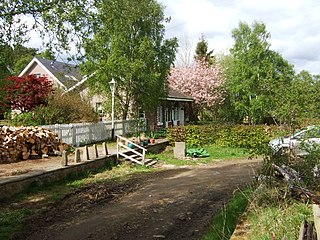
Dess railway station was opened on 2 December 1859 on the Deeside Extension Railway and served the rural area around Dess House and estate from 1859 to 1966 as an intermediate station on the Deeside Railway that ran from Aberdeen (Joint) to Ballater.
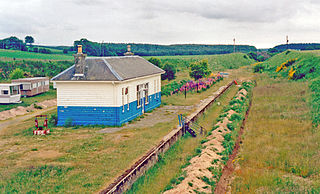
Urquhart railway station was a railway station serving the village of Urquhart, parish of Urquhart, Moray. The railway station was opened by the Great North of Scotland Railway (GNoSR) on its Moray Firth coast line in 1884, served by Aberdeen to Elgin trains.

Glassaugh railway station was a railway station that served the rural area of Glassaugh and the nearby Glenglassaugh distillery close to Portsoy in Moray. The railway station was opened by the Great North of Scotland Railway (GNoSR) on its Moray Firth coast line in 1884, served by Aberdeen to Elgin trains. The station closed to regular passenger traffic on 21 September 1953, more than a decade before the total closure of the line itself in 1968.

Holburn Street railway station was a railway station in Aberdeen, Scotland. It was opened in July 1894 by the GNSR and served a suburb of Aberdeen near Duthie Park and Allenvale Cemetery. The station was one of several victims of the 1937 closure of stations on the Aberdeen suburban service. The Deeside Railway itself eventually ran from Aberdeen (Joint) to Ballater.
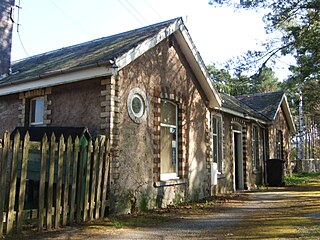
Dinnet railway station was opened on 17 October 1866 by the Aboyne and Braemar Railway and served Dinnet village from 1899 to 1966 as an intermediate station on the Deeside Railway that ran from Aberdeen (Joint) to Ballater. Dinnet is located close to the River Dee in the parish of Glenmuick, Tullich And Glengairn, Aberdeenshire, Scotland.
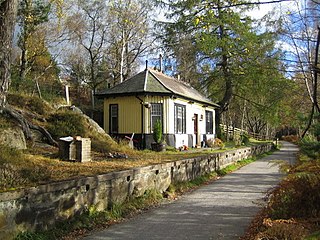
Cambus O'May railway station or Cambus O'May Halt, served Aberdeenshire, Scotland from 1876 to 1966 on the Deeside Railway. It was intended to serve the anglers on the River Dee, tourists, the 1874 Cambus O'May House hunting lodge and the local population of this rural district and stood 39 3⁄8 miles (63.4 km) from the Aberdeen (Joint) station. It was the last stop before Ballater.

Lumphanan railway station, Lumphanan, Aberdeenshire, Scotland stood from 1859 to 1966 on the Deeside Railway that ran from Aberdeen (Joint) to Ballater. It served the village of Lumphanan, Aberdeenshire, famous for its associations with Macbeth and King Malcolm III. It stood close to the Macbeth Arms Hotel.
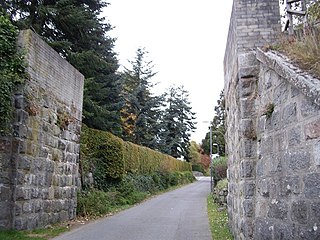
Torphins railway station served the village of Torphins from 1859 to 1966 on the Deeside Railway that ran from Aberdeen (Joint) to Ballater.

Glassel railway station is a disused railway station in Britain. It served Glassel House, the Mill of Beltie and the local farms and the inhabitants of this rural area from 1859 to 1966 on the Deeside Railway that ran from Aberdeen (Joint) to Ballater.

Aboyne Curling Pond railway station, Loch of Aboyne Platform or Curlers' Platform was a private station opened on the Deeside Extension Railway for the use of the curlers, who played on the nearby Loch of Aboyne close to the old Deeside Railway that ran from Aberdeen (Joint) to Ballater.
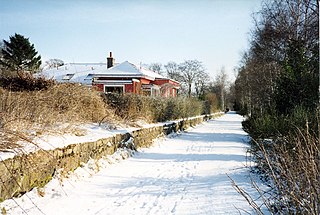
Murtle railway station, later Murtle Halt railway station served Murtle and Beaconhill Houses and estates, the Mill of Murtle, Milton of Murtle, the local farms and the inhabitants of this rural area within the parish of Peterculter from 1853 to 1937 on the Deeside Railway that ran from Aberdeen (Joint) to Ballater.

Milltimber railway station served the Milltimber area within the parish of Peterculter from 1854 to 1937 on the Deeside Railway that ran from Aberdeen (Joint) to Ballater. This area at that time had a number of mansion houses, estates, etc. such as Culter House, Fairgirth House, Camphill House, Avondow House, Glasterberry House, etc. whose workers, etc. would have used the station. Milltimber was only a short distance from Murtle station. The station was named for the nearby Milltimber Farm.

Bieldside railway station served the Bieldside area within the parish of Peterculter from 1897 to 1937 on the Deeside Railway that ran from Aberdeen (Joint) to Ballater. This area was the location of a number of mansion houses and estates such as Woodthorpe, Dalmunzie, The Firs, etc., some built as a result of the railway.

West Cults railway station served the small suburban village of West Cults area within the parish of Peterculter from 1894 to 1937 on the Deeside Railway that ran from Aberdeen (Joint) to Ballater. It lay very close to Cults and Bieldside.

Cults railway station was opened on 8 September 1853 by the Deeside Railway and served part of Cults with mansion houses such as Southfield, Wellwood, Woodbank, Inchgarth, Drumgarth and Norwood nearby. The Deeside Railway station was replaced in 1855 by a new GNoSR that remained open, despite the 1937 closure of many other stations on the Aberdeen suburban service, until 1966 as an intermediate station on the Deeside Railway that ran from Aberdeen (Joint) to Ballater. Cults is located in the parish of Peterculter, Aberdeenshire, Scotland.

Pitfodels railway station or Pitfodels Halt was opened on 2 July 1894 by the GNoSR and served a suburb of Aberdeen with housing and estates such as Wellwood, Inchgarth and Norwood. The halt was one of several victims of the 1937 closure of stations on the Aberdeen suburban service. The Deeside Railway itself ran from Aberdeen (Joint) to Ballater. Pitfodels is located in the parish of Peterculter, Aberdeenshire, Scotland.

Ruthrieston railway station or Ruthrieston Halt was opened in January 1856 by the GNSR and served Ruthrieston, now a suburb of Aberdeen. The halt was one of several victims of the 1937 closure of stations on the Aberdeen suburban service. The Deeside Railway itself eventually ran from Aberdeen (Joint) to Ballater. Ruthrieston is located in the parish of Peterculter, Aberdeenshire, Scotland.
Drum railway station was opened in January 1854 by the Deeside Railway and served the rural area around Drum Castle estate. The Deeside Railway was taken over by the GNoSR and in 1894 nearby Culter became the terminus for the majority of Aberdeen suburban services with only a few trains continuing through Drum to Banchory. Despite the 1937 closure of many other stations on the Aberdeen suburban service, Drum remained open until 1951 as an intermediate station on the Deeside Railway that ran from Aberdeen (Joint) to Ballater. Drum station was located in Drumoak Parish, Aberdeenshire, Scotland.
Mills of Drum railway station was opened in September 1853 by the Deeside Railway and served the rural area around Park House and Crathes estates at the Mills of Drum or Drum Mills, corn mills, that lay close to the River Dee. The Deeside Railway was taken over by the GNoSR in the 1860s. Mills of Drum only remained open until 1863 as an intermediate station on the Deeside Railway that ran from Aberdeen (Joint) to Ballater. Mills of Drum station was located in Deeside, Aberdeenshire, Scotland.

Park railway station was opened in September 1853 by the Deeside Railway and served the rural area around the Park estate, Nether Sunnyside, West Redford and the hamlet of Park. The Deeside Railway was taken over by the GNoSR and in 1894 nearby Culter became the terminus for the majority of Aberdeen suburban services with only a few trains continuing through Park to Banchory. Despite the 1937 closure of many other stations on the Aberdeen suburban service, Park remained open until 1966 as an intermediate station on the Deeside Railway that ran from Aberdeen (Joint) to Ballater. Park station was located in Drumoak Parish, Aberdeenshire, Scotland.























